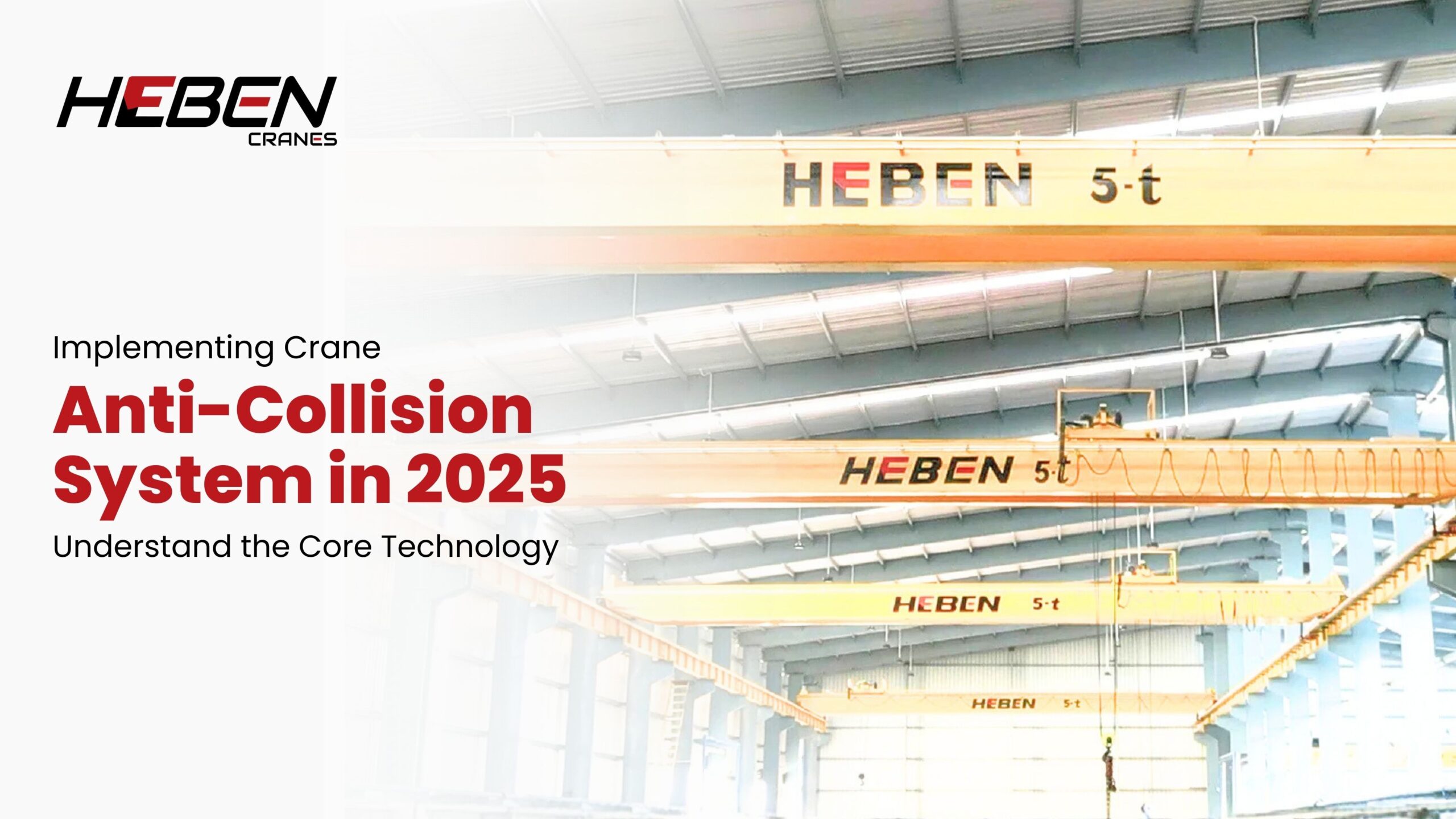As we move deeper into 2025, the landscape of crane safety has evolved dramatically, with anti-collision systems representing one of the most significant technological advancements in the industry. The overhead crane industry stands at the cusp of a significant transformation, driven by rapid technological innovation and the evolving needs of diverse sectors. This comprehensive guide explores the cutting-edge technologies, integration strategies, and practical considerations for implementing effective crane anti-collision systems in today’s complex operational environments.
Introduction: The Imperative of Safety in Modern Crane Operations
In today’s industrial landscape, crane operations form the backbone of manufacturing, construction, shipping, and numerous other sectors. However, these powerful machines present significant safety challenges that cannot be overlooked. The U.S. Department of Labor reported over 220 crane-related workplace fatalities between 2011 and 2021, highlighting the critical need for enhanced safety measures. As cranes become larger, faster, and more complex, the potential consequences of collisions grow increasingly severe.
Modern crane operations frequently involve multiple cranes working in close proximity, especially in congested construction environments. Traditional methodologies for crane operation depend on manual coordination, a process inherently susceptible to human error. This reality has driven the development of sophisticated anti-collision systems that leverage advanced technologies to prevent accidents, protect workers, and maintain operational continuity.
The financial implications of crane accidents extend beyond immediate damage. With penalties for non-compliance escalating by 15-20% annually in developed markets, the business case for implementing robust anti-collision systems becomes compelling for forward-thinking entrepreneurs entering this space.
Evolution of Crane Anti-Collision Systems: From Manual Oversight to Intelligent Automation
The journey from rudimentary safety measures to today’s sophisticated anti-collision systems reflects the broader technological evolution in industrial operations. In the early days, crane safety relied almost exclusively on operator skill and visual awareness. Communication between multiple crane operators often depended on radio systems or hand signals, with all the limitations these methods entail.
As Kenny Wright, an industry veteran, reflected on the automation revolution: “Remember when overhead crane operation required constant vigilance to avoid catastrophe? Those days are fading, but the need for safety remains paramount”. The transition from crude cranes to high-tech handling systems has transformed not just the technology but the entire operational paradigm.
Today, we stand at the threshold of a new era in crane safety where automation is revolutionizing safety and efficiency in groundbreaking ways. The overhead crane industry is witnessing smart cranes equipped with sensors, advanced analytics, and machine learning capabilities that enable predictive maintenance, optimized operations, and enhanced safety measures. These intelligent systems can detect and prevent potential collisions, overload situations, and other safety hazards, significantly improving workplace safety.
Core Technologies Driving Anti-Collision Systems in 2025
Advanced Sensing Technologies
The foundation of modern anti-collision systems lies in their sophisticated sensing capabilities:
- Radar and Laser Technology: In 2025, advanced anti-collision systems are utilizing radar and laser technology for extremely precise obstacle detection and collision prevention. These technologies provide millimeter-level precision and function reliably in challenging environmental conditions, including dust, fog, and poor lighting.
- GPS Integration: The most advanced frameworks employ sophisticated technologies including GPS, sensors, and instantaneous data transmission to oversee crane locations and issue collision alerts. By integrating real-time data analysis and automated control, these systems effectively prevent crane collisions, safeguarding personnel and minimizing project interruptions.
- Multi-Sensor Arrays: Rather than relying on a single detection method, modern systems combine data from multiple sensor types to create comprehensive awareness of the operational environment. This redundancy significantly enhances reliability while providing backup if one system experiences failure.
Artificial Intelligence and Machine Learning
The intelligence behind modern anti-collision systems comes from sophisticated data processing:
- Predictive Collision Detection: AI algorithms analyze movement patterns to predict potential collisions before they occur. Instead of simply reacting to imminent dangers, these systems anticipate hazardous trajectories based on current movements and historical data.
- Real-Time Data Processing: Modern systems process massive amounts of sensor data in milliseconds, enabling instantaneous decision-making. The processing layer uses advanced algorithms to predict potential collisions based on crane positions and movements, while the control layer implements safety measures when necessary.
- Self-Learning Capabilities: The most sophisticated systems continuously improve their predictive accuracy through machine learning. For example, Liebherr’s Lakrunner crane uses AI algorithms to detect structural stress anomalies, representing just one application of how intelligent systems are transforming crane safety.
System Architecture Components
Effective anti-collision systems consist of three key architectural layers:
- Sensing Layer: Captures data from GPS and sensors installed on each crane to monitor positions, movements, and environmental conditions.
- Processing Layer: Employs sophisticated data processing algorithms to predict potential collisions based on crane positions and movements, analyzing this information in real-time.
- Control Layer: Implements safety measures such as visual and audio alarms, and automatic overrides to crane operation systems when necessary to prevent collisions.
Integration with Crane Control Systems: Achieving Seamless Operation
Unified Control Architecture
For maximum effectiveness, anti-collision systems must integrate seamlessly with broader crane control systems:
- Centralized Motion Controllers: Advanced controllers like Siemens’ SIMOTION D completely relieve the crane PLC from technological crane drive tasks. This centralized approach enables seamless integration of anti-collision functions with other operational controls, creating a unified system architecture.
- Standardization Benefits: As technology has evolved, cranes have become bigger, faster, and more complex electrically. Leading suppliers now offer innovative drive and control system solutions that provide crane builders, system integrators, and end-users with standardized yet flexible hardware and software solutions.
- Automation Integration: A powerful central motion controller facilitates the integration of crane motion control with automation, enhancing both safety and operational efficiency. This integration represents a significant advancement over traditional control methodologies that relied heavily on programmable logic controllers.
Human-Machine Interface Considerations
Despite increasing automation, effective human-machine interaction remains crucial:
- Operator Experience: As industry experts emphasize, “Though cranes are evolving quickly, the human element still remains vital through the automation revolution”. Well-designed systems balance automation benefits with appropriate human oversight.
- Training Requirements: Implementing advanced anti-collision systems requires comprehensive operator training. As Tad Dunville notes, “When you have people with a two-page or three-page proposal for automating a crane that says automate the crane. Someone with a 300-page one that specifies where the rail cars are and how dynamic the rail car positioning can be. That’s not apples to apples at that point”. This highlights the importance of detailed system understanding.
Enhancing Operational Efficiency and Safety through Real-Time Monitoring
Comprehensive Monitoring Capabilities
Modern systems extend well beyond basic collision prevention:
- Remote Monitoring Systems: These enable real-time monitoring and control of crane operations from a centralized location. With the help of sensors and data connectivity, operators and project managers can track crane performance, monitor load capacities, and detect potential issues remotely. This allows for proactive maintenance and troubleshooting, minimizing downtime caused by unexpected breakdowns.
- Real-Time Data Analytics: By collecting and analyzing data on various aspects of crane operations, such as load capacities, working hours, and productivity, project managers gain valuable insights. These insights help identify bottlenecks, optimize workflow, and make informed decisions to improve efficiency. Real-time analytics also enables identification of trends and patterns, allowing for predictive maintenance and proactive planning.
- Digital Planning Tools: These streamline the planning and scheduling process of crane operations, allowing project managers to visualize and optimize crane utilization within the project timeline. This comprehensive approach to monitoring and management significantly enhances both safety and operational efficiency.
Predictive Maintenance and Performance Optimization
Data-driven insights enable proactive approaches to maintenance and performance:
- Sensor-Based Condition Monitoring: Smart cranes equipped with sensors will monitor crane health, anticipate potential failures, and schedule maintenance proactively, minimizing downtime and repair costs.
- Operational Analytics: Data analysis identifies operational bottlenecks, optimizes lifting paths, and improves overall efficiency, creating a smarter operational environment.
- Performance Tracking: Continuous monitoring of performance metrics enables ongoing optimization, ensuring that cranes operate at peak efficiency while maintaining rigorous safety standards.
Customization and Scalability: Adapting Systems to Diverse Operational Needs
Industry-Specific Adaptations
Anti-collision systems must accommodate unique requirements across different operational environments:
- Modular Design Philosophy: One of the standout features of modern crane systems is their ability to be fully customized in terms of span, height, and load capacity. This modular approach allows businesses to install systems that meet their current needs and upgrade later without replacing the entire infrastructure.
- Application Flexibility: These systems can be tailored for diverse industries including manufacturing, automotive, electronics, and logistics, where versatility is key. They can be installed in spaces ranging from small workshops to large warehouses, offering businesses the ability to lift and transport materials with ease and precision.
- Scalable Solutions: Unlike traditional fixed cranes, modern modular systems consist of components that can be easily assembled, adjusted, and expanded according to specific business needs. This scalability ensures that safety systems can grow alongside operational capacity.
Customization Parameters
Key aspects of anti-collision systems can be tailored to specific requirements:
- Physical Customization: Systems can be adapted for span, height, and load capacity considerations specific to each operational environment.
- Functional Customization: Detection sensitivity, intervention thresholds, and integration depth can all be adjusted based on operational requirements and risk tolerances.
- Industry-Specific Configurations: Different sectors—from construction to maritime to manufacturing—require unique configurations that address their specific safety challenges and operational patterns.
Regulatory Compliance and Industry Standards: Meeting Global Safety Requirements
Global Safety Framework
Crane operations navigate a complex landscape of safety regulations:
- Stringent Regulatory Environment: Safety regulations are the cornerstone of demand for crane inspection and certification services globally. Industries such as construction, manufacturing, and energy must comply with regional and international standards, including OSHA in the U.S., LOLER in the UK, and ISO 9927-1:2013.
- Inspection Requirements: Regulatory bodies increasingly mandate periodic inspections, with penalties for non-compliance escalating by 15–20% annually in developed markets. For example, the International Maritime Organization requires dockside cranes to undergo load testing every 5 years, driving recurring demand for certification.
- Technological Compliance: The integration of IoT sensors, AI-driven monitoring tools, and automation in modern cranes necessitates specialized inspection protocols. As industries adopt smart cranes with predictive maintenance capabilities, certification services must evolve to validate both hardware and software compliance.
Certification and Documentation
Implementation involves formal validation processes:
- Certification Requirements: Anti-collision systems typically require certification by recognized authorities to validate compliance with applicable safety standards.
- Documentation Protocols: Comprehensive documentation of system specifications, testing results, and operational parameters is essential for both compliance and effective system management.
- Regular Validation: Ongoing testing and certification ensure that systems continue to function as designed throughout their operational life.
Conclusion: Strategic Implementation for Enhanced Safety and Productivity
The implementation of crane anti-collision systems in 2025 represents far more than a safety checkbox—it constitutes a strategic investment in operational excellence. Organizations that approach implementation thoughtfully can realize benefits extending well beyond accident prevention.
Successful implementation begins with comprehensive needs assessment, understanding specific operational requirements, environmental conditions, and regulatory obligations. This assessment should consider both current needs and anticipated future requirements to ensure scalability.
Integration planning represents another critical success factor. Anti-collision systems function most effectively when seamlessly incorporated into broader operational technologies and workflows. This integration requires collaboration across technical teams, operations personnel, and safety specialists.
The human dimension remains essential despite increasing automation. As industry veterans emphasize, “removing workers from harm’s way is crucial, but experienced oversight endures when modernizing safety”. Implementation plans must include comprehensive training programs that build both technical competence and safety awareness.
Looking forward, crane anti-collision technology will continue to evolve. The integration of more sophisticated AI, enhanced sensing capabilities, and deeper operational integration will further enhance both safety and efficiency. Organizations that establish adaptable foundational systems today position themselves to leverage these future advancements.
For entrepreneurs entering this space, understanding both the technological foundations and implementation considerations of crane anti-collision systems offers a significant competitive advantage. As cranes become smarter, safer, and more sustainable, those who can navigate this technological transformation will be well-positioned to capitalize on the growing demand for advanced safety solutions in industrial operations.





